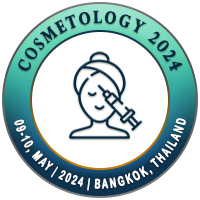
Sabir Hasanbeyzade
Private Dermatovenerology Clinic, TurkeyTitle: Evaluation of the demographic and clinical characteristics of patients diagnosed with Granulomatous Rosacea: Evaluation of 8 cases
Abstract
Granulomatous rosacea (GR) is a rare inflammatory variant of rosacea characterized with reddish brown or flesh-colored papules mostly localized on the face, especially on the forehead, around the eyes and mouth, and is generally more common in middle-aged women. We examined patients who applied to our outpatient clinic between 2016-2022 and were diagnosed with GR.A total of 8 patient records were accessed.7 (87.5%) of the patients were female and 1 (12.5%) was male. The average age of the patients was 43.5±2.6 (male was 52).While 7 of the patients had only facial involvement, one patient also had lesions on the ears. This patient was a woman and her age was 49,above the average age of the other patients. The lesions on the face and ears were in the form of erythematous papules, in some patients, there was also fine scaling (Figure 1) on the lesions, and the lesions tended to coalesce and form plaques. In 6 (75%) of the patients, the disease had just started (33±8 days) and this was their first examination at the dermatology clinic with this complaint. In 2 (25%) patients, the complaints had been present for a longer period of time (both were female patients; they had >2m history).The first of these patients was the patient who also had involvement in her ears. These two patients both had used topical medium-potent corticosteroid creams, but they did not describe any improvement. We started all patients on systemic doxycycline 100 mg 1x1 and topical 0.75% metronidazole cream for 14 days. The lesions resolved completely in 7 of the patients. After, patients were called for a follow-up check after 3 months. Only in one patient who had the disease for a long time and used topical steroids, although the lesions regressed, they did not disappear completely. Therefore, the patient was advised to continue only topical metronidazole for another 2 weeks, and at the end, the lesions had completely disappeared. At 3-month follow-up, none of the patients had active lesions or relapses. Two of the patients had hypertension and were each using medication for its treatment. One of these patients was a female patient who also had involvement in her ears, had a long history of the disease, and did not improve with topical steroids previously. We have seen that the disease may be resistant to treatment in older ages in those with comorbidities and involvement in areas other than the face. But large patient numbers and case-control studies are required to clarify this.
Biography
Sabir Hasanbeyzade graduated from the Faculty of Medicine in 2012 and completed his dermatology specialization at the Gülhane Military Medical Academy in Turkey in 2016. He currently works in his own private dermatovenerology clinic.

